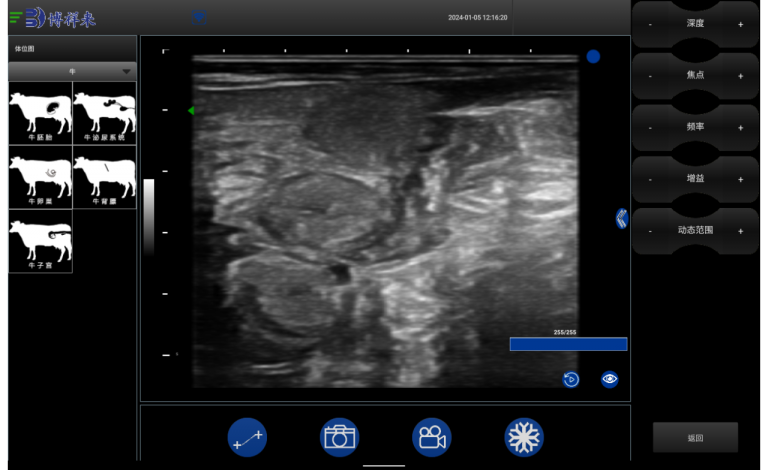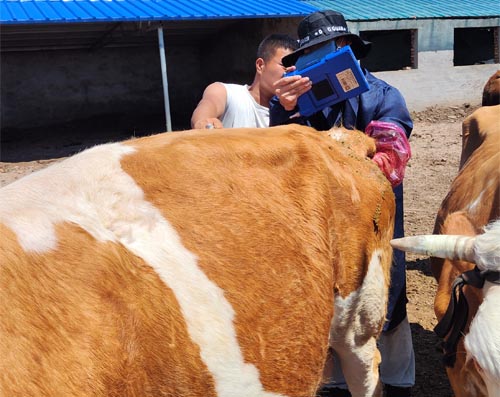How Farms Detect Cow Uterine Infections Using Ultrasound
When cows show a drop in fertility or irregular behavior after calving, one hidden culprit that’s often overlooked is a uterine infection. These infections can silently sabotage reproduction cycles, reduce milk yield, and impact overall herd health. Thankfully, modern farms now rely on a quick, safe, and accurate method to detect these problems—ultrasound. It’s a non-invasive game changer that helps farmers and veterinarians take action before things get worse.

Understanding Uterine Infections in Cows
Uterine infections in cows—also called metritis or endometritis—usually occur after calving, especially when there’s a retained placenta, difficult birth, or poor hygiene during delivery. These infections range from mild, with barely noticeable symptoms, to severe, where the cow’s uterus fills with fluid, pus, or debris that prevents future pregnancies.
You might not always see external signs, but infections can still be active inside. That’s where ultrasound becomes incredibly valuable—helping us see what’s happening in the uterus without any surgery or blood tests.
Why Ultrasound Is a Farmer’s Best Friend
Veterinary ultrasound, particularly B-mode imaging, gives a clear view of the cow’s uterus, ovaries, and other reproductive structures. It works like a flashlight inside the body. Instead of guessing, farmers and vets get instant feedback on whether the uterus looks healthy or shows signs of infection.
Here’s why it works so well on farms:
-
Completely non-invasive: No needles, no sedation, no stress for the animal.
-
Real-time feedback: You can spot abnormalities right away—fluid pockets, thickened uterine walls, or retained fetal membranes.
-
Fast and repeatable: Exams take only a few minutes, and you can easily monitor recovery over time.
-
Portable devices: Handheld veterinary ultrasound scanners can be carried to any barn, field, or calving pen.
What Ultrasound Actually Shows in Infected Cows
When you scan a cow’s uterus with ultrasound, a healthy postpartum uterus should appear with thin walls, no significant fluid buildup, and symmetrical structure. If there’s an infection, the images will often show:
-
Hypoechoic (dark) or hyperechoic (bright) areas: These represent fluid accumulation, pus, or even necrotic tissue.
-
Enlarged uterus: An infected uterus is often distended due to retained fluids.
-
Thickened endometrium: The inner lining of the uterus becomes visibly swollen and inflamed.
-
Gas shadows: In severe infections, gas-producing bacteria create bright spots with dirty acoustic shadowing.
These details help vets classify the severity of the infection and recommend the right treatment—whether that’s intrauterine antibiotics, flushing, or hormone therapy.
Timing Is Everything: When to Scan for Uterine Health
Most veterinarians recommend doing a routine ultrasound check about 20 to 30 days after calving. At this point, the uterus should be well on its way to involution (shrinking back to pre-pregnancy size). If it’s still enlarged or full of fluid, that’s a red flag.
Scanning too early (like within the first week after birth) can show misleading fluid levels, as the uterus naturally takes time to clear itself. But if problems persist beyond day 30, it often signals chronic endometritis or delayed recovery. That’s when treatment is essential—not just for that cow, but for the whole herd’s reproductive schedule.

Real-Life Farm Scenarios: Spotting the Invisible
Let’s say a dairy cow calved 25 days ago. She seems okay but hasn’t shown signs of heat yet. On a routine scan, the vet notices a large amount of fluid and thick uterine walls—classic signs of subclinical endometritis. Without ultrasound, this would go undiagnosed, and the cow might get bred too soon, leading to failed conception.
Another cow, 40 days postpartum, has a visibly distended uterus and a foul-smelling discharge. An ultrasound confirms the presence of gas and purulent material. Immediate flushing and antibiotic therapy are started, and within two weeks, the uterus is clear and the cow is cycling again.
These stories are common, and they highlight how valuable ultrasound can be—not just for diagnosis, but also for monitoring progress during treatment.
The Broader Impact: Reproduction, Milk, and Profits
A healthy uterus is the foundation of a productive cow. Uterine infections not only delay conception but also reduce milk output and increase culling rates. Every extra day a cow stays open (not pregnant) costs money—up to $3–$5 per day on average.
Using ultrasound to detect infections early helps reduce:
-
Days open
-
Number of failed inseminations
-
Vet costs for advanced treatments
-
Unnecessary culling of cows that could have been saved
And let’s not forget—healthy cows are just happier. They eat better, produce more, and get pregnant faster.
Tips for Farmers Using Ultrasound
You don’t need to be a vet to appreciate how useful this tool can be. Here are a few practical tips for farmers working with ultrasound:
-
Work with a trained technician: Proper probe handling and interpretation matter.
-
Clean the rectum well before scanning: A clean scan gives clearer images.
-
Record findings consistently: Keeping track helps monitor changes over time.
-
Don’t wait for obvious symptoms: Subclinical infections are more common than you think.
On many progressive farms, ultrasound exams are now routine—not just for checking pregnancy, but as a vital part of postpartum care.
Looking Ahead: Smarter Herd Management
The future of farm management is all about early detection and precision care. With portable ultrasound scanners becoming more affordable and rugged, even small and medium farms are adopting this technology. Some models even connect to apps, allowing cloud-based tracking of uterine health across the herd.
Add that to improved AI-powered image interpretation, and you’ve got a future where infections don’t stay hidden for long. It’s all part of a smarter, more data-driven approach to animal health.
Final Thoughts
Ultrasound has quietly become one of the most important tools for managing reproductive health in dairy and beef cattle. By giving us a real-time look inside the uterus, it allows faster, more accurate decisions—and helps cows recover faster. Whether it’s spotting infections before they affect fertility or guiding treatment, ultrasound is reshaping how farms maintain herd productivity.
When used consistently, this technology not only saves animals—it saves money, time, and stress. And for farmers everywhere, that’s the kind of win we’re all looking for.





